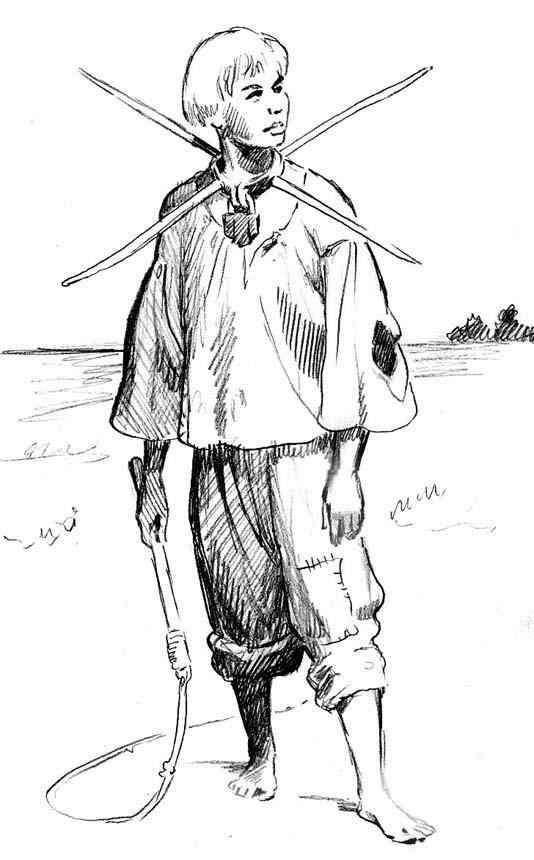
Russian Serf Boys

Figure 1.--This is an illustration of a serf shepherd boy from a Soviet-era children's book. I do not know the book or who the illustrator was. We know that some land owners made serf boys wear iron collars like this which were called "rogatka". The collars made it difficut not only for the boys to run away, but to lay down or sleep pn the job. What we do not know is how common it was.
|
|
Serf boys like their fathers were primarily employed for agricultural work in fields and farms. Serfs were not exclusively agricultural workers, but the great majority were so employed. From May through October serfs commonly worked barefoot. Serfs during the winter were given shoes. The serfs had rough shirts and canvas trousers. The Russian serf boys were divided into two categories - ordinary serf boys (krepostnye) and yard boys (dvorovye). Landowners varied greatly as to how they treated their serfs. This varied with both the landlord and the type of serf boy involved. Some brutal landowners would put boys into iron collars both as punishment and for discipline. At night some serfs slept in special sheds, all together on straw. Frequently in these sheds stood heavy wooden fetters to ensure that they would not escape. When serf boys lay down to sleep, they put bare feet into these fetters. These iron collars and wooden fetters were not the general phenomenon in old Russia, but they were used by some landowners.
Ordinary Serf Boy (Krepostnye)
The ordinary boys lived in villages with parents and were involved with the usual village works in fields or as herd boys. The regime of these serf boys, in part
because they lived with their parents, was a much more humane condition than that of the yard boys. In the summer serf boys were clothed usually only in canvas shirts and pants. Boys also commonly wore a canvas shirt and a long linen jacket (kaftan). Such clothes might be worn in spring or autumn. Boys during the winter and other cold days might wear bast shoes (lapti). In the summer serf boys would go barefoot.
Yard Boys (Dvorovye)
Yard boys in at the age of approximately 12-14 years were selected among the ordinary serf boys for work on the manor of the
landowner. These boys were taken from their parents under duress or bought from other landowners. Yard boys were used to work in the house of the landowner, in his stables and farms. Some landowners used the boys for work at the small factories (manufacture of a paper, bricks, etc.). Yard boys lived in special barns on owner's villa. For sleeping in barns there were common wooden beds covered by straw. As blankets the pieces of a rough cloth were used. The regime for the yard boys was more severe, than that of other serf boys. They were frequently were put in collars and fetters.
Footwear
The yard boys, which worked in landowner's house, stables and farms frequently did not have any footwear and the year round went and
worked barefoot. There were cases, when especially severe landowners punished the boys by forcing them to work barefoot in yards on a frost (to clean snow,
carry fire wood, etc.).
Iron collars
In Russia prior to the beginning of the 19th century the special design iron collar (rogatka) for serfs was applied. This collar had outside long thorns. Boys wearing such a collar couls not possibly lay down. The boys were put in such collars for outdoor work in fields and pastures to ensure that they would not sleep or rest during working hours. So that shepherds boys would not drink milk from cows in the pasture, they were sometimes put in special metal face bridles. The same bridles were put on boys working on vineyards (southern Ukraine, Crimea) so that during working time they could not eat the grapes. Iron collars without thorns were used on serfs working in factories. Such collars usually had an iron chain, which was attached to a wall at the place of work. The British traveler J.Cox, visiting Russia at the end of 18th century wrote that he personally saw two serf boys 12 and 14 years old. in collars with chains.
Wooden fetters
Wooden fetters were applied in Russia up to mid-19th century. In the old literature there are accounts of such wooden fetters which put on the necks of serfs, but feet fetters (leg irons were rarely used) were more common. It was not possible to work in these wooden fetters, but they were used at night. Yard boys were put in fetters at night so that they could not run away. Fetters in serf sheds consisted of two long oak boards, in which the round holes (two holes for each serf) were cut. When the serf boys lay down to sleep, serfs supervisor opened the lock at fetters and lifted the top board. Boys put bare feet in holes, then the top board fell and supervisor locked fetters. One fetter might be used for up to 10 serfs.
HBC

Navigate the Boys' Historical Clothing Web Site:
[Return to the Main Russian Serfdom page]
[Return to the Main Russian peasantry page]
[Return to the Main Russian activities page]
[Return to the Main music page]
[Introduction]
[Activities]
[Biographies]
[Chronology]
[Clothing styles]
[Countries]
[Girls]
[Topics]
[Bibliographies]
[Contributions]
[FAQs]
[Glossaries]
[Images]
[Links]
[Registration]
[Tools]
[Boys' Clothing Home]
Navigate the Historic Boys' Clothing Russian pages:
[Ballet]
[Children's literature]
[Choirs]
[Fashion magazines]
[Movies]
[Royalty]
[School uniform]
[Youth groups]
Navigate the Boys' Historical Clothing Web Site:
[Return to theMain country page]
[Australia]
[Canada]
[England]
[France]
[Germany]
[Ireland]
[Italy]
[Mexico]
[New Zealand]
[Poland]
[Scotland]
[United States]
Created: 6:42 PM 3/10/2008
Last updated: 6:42 PM 3/10/2008



